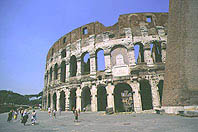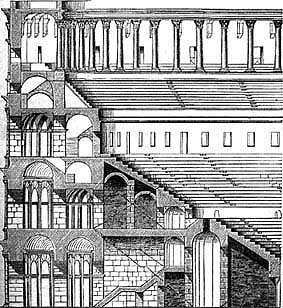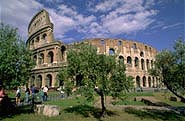Colosseum
Colosseum
 (Colosseo) It is ironic that this sublimely beautiful arena was built for people to enjoy the ugliest spectacle of all: death to man and beast.
(Colosseo) It is ironic that this sublimely beautiful arena was built for people to enjoy the ugliest spectacle of all: death to man and beast.
Other amphitheaters are in France, Italy, Spain, and North Africa - many still in use today for shows, bullfights, operas.
At its inception in 1C AD, this gigantic ellipse was called the Flavian Amphitheater, Flavius being the family name of Emperor Vespasian who started it. He took away the lake from the inordinately large garden of Nero's nearby Golden House (Domus Aurea), filled it in, and here built the largest Amphitheater in the world, to "amuse" the populace, showing fantastic spectacles of gladiators in bloody combat with wild animals.
Entry was free! This is living proof that the emperors believed in keeping the Roman citizens happy by giving them "bread and circuses". Many of the emperors also gave away flour for the people's daily bread.
A perfect oval of brick faced with white travertine marble, the Colosseum rises 4 stories high. The first story has Doric pillars, second Ionic, third and fourth Corinthian. It covers 7.5 acres and has a circumference of 1,730 ft.
The large holes in the facade - making the building look as if had been shelled - are where the marble blocks were originally held together by metal clamps, which have now been stolen. Also, there used to be brackets supporting paraffin torches and banners.
All the metal and a great deal of the marble was literally ripped off the building, making the Colosseum also the world's largest quarry for building materials.
Superb engineering went into the building.
 50,000 spectators could be seated within 10 minutes through the 80 numbered entrances and large corridors for easy access for the raucous throngs. The Emperor and his suite had their own entrance.
50,000 spectators could be seated within 10 minutes through the 80 numbered entrances and large corridors for easy access for the raucous throngs. The Emperor and his suite had their own entrance.
The Gate of Life was for pardoned gladiators; the Gate of Death for those killed.
The spectacles started at dawn, and didn't finish till dusk. High officials, nobles and senators sat at the same level as the Emperor, rich merchants in the section above, freed men above them, women still higher, and slaves and the sailors responsible for the "Velarium" in the topmost section.
There was an enormous circular tenting, called "Velarium", used to keep the sun and rain off the spectators. This giant awning was a hollow disc like a donut, leaving the arena in the center open to the skies. Hauling it up was a Herculean task, with squads of sailors pulling the ropes to the beat of a kettledrum. The sailors, whose experience raising ships' sails had taught them nautical precision, chanted to keep themselves in time.
The show started with the gladiators, gorgeously dressed, solemnly parading around the arena - which was surfaced with wooden planks covered by sand (sand in Latin is "arena"). The sand, by the way, was there to soak up the blood. They would then shout the ritual "Ave, Imperator, morituri te salutant" (Hail to the Emperor, those about to die salute thee).
Dozens of elevators manned by slaves working pulleys could bring up 1,000 warriors at the same time, 10 men per lift - or else hundreds of lions. Or both. Christians were sometimes hurled to hungry lions.
![]() Our favorite: spotting the grooves, in the underground walls, along which the elevators rose to the arena floor. Nowadays on Good Friday, the Pope participates in the procession of the "Stations of the Cross".
Our favorite: spotting the grooves, in the underground walls, along which the elevators rose to the arena floor. Nowadays on Good Friday, the Pope participates in the procession of the "Stations of the Cross".
| Colosseum History
|
Via dei Fori Imperiali (Map K 8)
 72 AD. Emperor Vespasian, to propagate blood sports, started building the ancient world's largest and finest stadium.
72 AD. Emperor Vespasian, to propagate blood sports, started building the ancient world's largest and finest stadium.